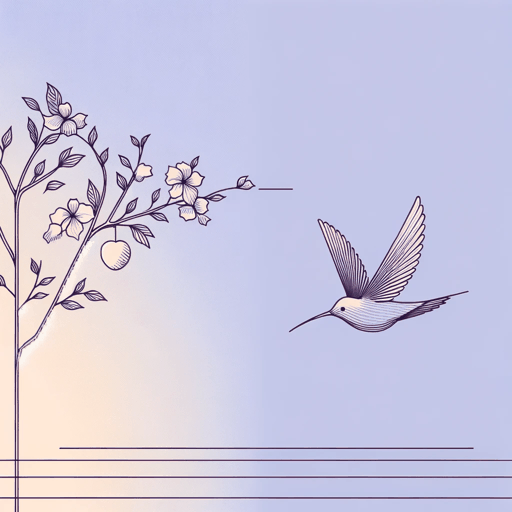17 pages • 34 minutes read
Lorna Dee CervantesEmplumada
Fiction | Poem | Adult | Published in 1981A modern alternative to SparkNotes and CliffsNotes, SuperSummary offers high-quality Study Guides with detailed chapter summaries and analysis of major themes, characters, and more.
Summary and Study Guide
Overview
“Emplumada” by Lorna Dee Cervantes appears in the collection of the same name, published in 1981 by the University of Pittsburgh Press. The poem consists of 18 lines in three stanzas of unrhymed free verse. As part of Cervantes’ first collection, “Emplumada” introduces some of the major concerns of the poet, including struggles of class, culture, and historical marginalization. In the beginning of the poem, the speaker draws the reader’s attention to the flowers that, beautiful in their season, die at summer’s end. The speaker goes on to notice stone fruit climbing above a fence line, and beyond, two hummingbirds joined mid-air. The birds are united in their struggle to both survive and “to find what is good” (Line 13). As feathered creatures, they can take solace in flight and are free to leave—to propel themselves into a different situation as the wind and their strength allows. The word “emplumada” translates to “feathered,” as well as “pen flourish,” the latter underscoring the liberating power of poetry.
Poet Biography
Lorna Dee Cervantes was born in San Francisco in 1954 to parents of Mexican and Native American (Chumash) ancestry. In an effort to protect their children from racism, Cervantes’ parents allowed only English to be spoken in the home. This cultural disconnect would play a large role in the poetry and activism of Cervantes’ career as Cervantes explored the intersections, clashes, and chasms between Chicanx, African American, and Anglo cultures as well as across gender and economic divides.
Cervantes developed an interest in poetry at the library where her brother worked. Early influences on Cervantes’ poetry include Shakespeare, Byron, Shelley, and Keats. She first performed her poetry for a large audience when she was asked, last minute, to read as part of Theater of the People of San Jose at the Quinto Festival de los Teatros Chicanos in Mexico City in 1974. Her selection, “Refugee Ship,” later became part of her award-winning debut collection, Emplumada (1981).
Cervantes’ other collections include From the Cables of Genocide: Poems on Love and Hunger (1991), DRIVE: The First Quartet (2006), Ciento: 100 100-Word Love Poems (2011), and Sueño: New Poems (2013). She is the founder of Mango, a literary review which championed the early work of authors including Sandra Cisneros, Jimmy Santiago Baca, Alberto Rios, and Gary Soto, among many others. She also co-edited the cross-cultural literary journal, Red Dirt. Cervantes has read and performed her work widely. She served as Associate Professor of English at University of Colorado at Boulder from 1988 until 2007 and was a lecturer at UC Berkeley from 2011 to 2012. In 2012, she participated in the Libroaficante Movement, an effort to replace books deemed subversive and racially provocative by the Arizona legislature and which were removed from classrooms after the passage of Arizona House Bill 2281.
Awards include the Paterson Prize for Poetry, the Lila Wallace-Reader’s Digest Award, the Latino Book Award, two Pushcart Prizes, two NEA Fellowships, and the American Book Award, among others.
Poem Text
Cervantes, Lorna Dee. “Emplumada.” 1982. Poetry Foundation.
Summary
“Emplumada” by Lorna Dee Cervantes begins with a picture of summer’s end—the fading blossoms of the snapdragon, once glorious and full of vibrant color, now “withered” (Line 2). The reader is introduced to the third-person speaker of the poem in the first stanza, when the reader is told how “she hated to see” (Line 6) the flowers in their decline, remembering their spring bloom and subsequent bright existence. She is still thinking of when “the weather was good” (Line 8) when she notices, beyond a fence, the climbing fruit of a peach tree. Two hummingbirds, together in flight, catch her eye. She notes the effort it takes for them to hover in unison and to harvest what nectar they can from what is available. She sees the birds as fighters who can harness the wind and escape their struggle in flight. On the wing, the feathered creatures are able, according to the speaker, to free themselves from the tyranny of the seasons.

